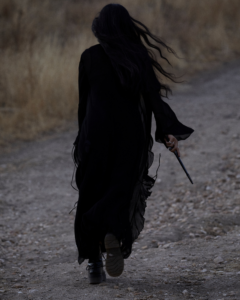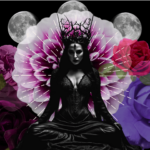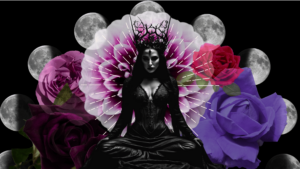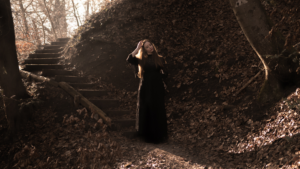The Goddess Path: Reclaiming Divine Feminine Power
The Divine Feminine and Its Significance
Defining the Divine Feminine
The Divine Feminine is central to the Goddess Path, the sacred embodiment of feminine energy in its full spectrum, encompassing both creation and destruction, light and shadow, nurturing and untamed power. It represents intuition, wisdom, sensuality, transformation, and the cyclical nature of existence. This energy is not limited to gentle, passive qualities but also includes the fierce, unapologetic forces of change, sovereignty, and deep personal evolution.
Unlike the conventional understanding of femininity imposed by society, the Divine Feminine is not limited to gender; it is an energetic principle accessible to all beings, balancing the structured and active nature of the Divine Masculine. This sacred force manifests in myths, symbols, and deities across cultures, guiding those who seek harmony, self-discovery, and empowerment.
The Role of the Divine Feminine in Spiritual and Personal Development
The Divine Feminine is a deeply transformative force, fostering inner growth and holistic well-being. It encourages people to cultivate deep self-awareness, intuition, emotional intelligence, and a connection with nature. People who work with the Divine Feminine experience heightened creativity, spiritual awakening, and the courage to embrace their full, authentic selves. This energy also plays a critical role in healing patriarchal wounds, helping people reclaim lost aspects of their power and rewrite limiting narratives.
Manifestations of the Divine Feminine in Different Traditions
The Divine Feminine is universally recognized, appearing in different forms across cultures and traditions. For example:
Egyptian Tradition: Isis, the mother of magic and wisdom, embodies sovereignty, fertility, and the power of resurrection.
Hindu Tradition: Shakti represents the cosmic force of creation, manifesting through goddesses like Kali (destruction and transformation) and Lakshmi (abundance and prosperity).
Greek and Roman Mythology: Goddesses such as Artemis (independence and wild nature) and Aphrodite (love and beauty) offer diverse expressions of feminine power.
Celtic Tradition: Brigid, a goddess of healing, poetry, and smithcraft, connects with elemental forces and the cycles of life.
Indigenous and African Spirituality: Mother Earth figures, such as Pachamama in Andean traditions and Yemaya in Yoruba cosmology, symbolize the nurturing and life-giving aspects of the Divine Feminine.
These diverse expressions of feminine divinity highlight its multifaceted nature, affirming that goddess spirituality transcends cultural boundaries and is integral to human experience.
Historical Context and Erasure
Goddess Worship in Ancient Civilizations
Ancient societies revered goddesses as supreme deities, honoring them through temples, rites, and oral traditions. Early matrifocal cultures, such as those in Neolithic Europe, depicted goddesses as sources of fertility, protection, and wisdom. The Minoan civilization of Crete, for example, centered its spiritual life around goddess worship, as seen in figurines of the Snake Goddess, symbolizing renewal and power.
Suppression of Goddess Traditions by Patriarchal Systems
With the rise of patriarchal systems, goddess worship was systematically suppressed. As male-dominated religious and political structures gained influence, feminine deities were either diminished, absorbed into male-centered pantheons, or vilified. The transition from goddess-centric to god-dominated spiritual frameworks marked a shift in societal values, de-emphasizing the sacredness of the feminine and redefining power in hierarchical terms.
Destruction of Sacred Sites and Demonization of the Feminine
The suppression of the Divine Feminine was not just ideological—it involved the destruction of sacred sites, the rewriting of religious narratives, and the persecution of those who upheld goddess traditions. These actions led to the loss of many spiritual lineages that honored feminine divinity.
A major example is the burning of the Library of Alexandria, which housed invaluable texts on goddess worship and mystical traditions. Its destruction symbolized the suppression of female-centric spiritual knowledge, diminishing the role of goddesses in spiritual practice.
During the Christianization of Europe, pagan sites were systematically converted into Christian places of worship, erasing the Divine Feminine’s significance. Many goddess temples were destroyed or repurposed as churches, like the Pantheon in Rome, originally a temple to Cybele and other deities.
The witch trials of the Middle Ages were another brutal aspect of this suppression. Women who preserved ancient feminine knowledge—particularly in herbal medicine, healing, and spiritual practices—were accused of witchcraft and executed. These women, often healers and midwives, were seen as threats to patriarchal institutions, reinforcing deep-seated fears about female autonomy and wisdom.
Despite centuries of suppression, the Divine Feminine has never been fully extinguished. The resurgence of goddess spirituality today is a testament to the enduring power of these ancient traditions, allowing people to reconnect with their ancestral roots and reclaim lost wisdom.
These systematic efforts to erase goddess-centered traditions were driven by fear of feminine power—its autonomy, its connection to nature, and its ability to inspire self-sovereignty.
Light Goddesses vs. Dark Goddesses
Understanding the Differences Between Light and Dark Divine Feminine
The Divine Feminine expresses itself in many ways, but it is often categorized into “light” and “dark” aspects. The Light Divine Feminine embodies nurturing, compassion, love, beauty, and fertility—qualities that are often celebrated and accepted within patriarchal structures. Light goddesses such as Aphrodite (in her popular conception anyway-the truth is she has dark chthonic aspects that have been erased), Lakshmi, and Kuan Yin represent harmony, abundance, and benevolence, making them easier to integrate into mainstream spiritual practices.
On the other hand, the Dark Divine Feminine encompasses power, transformation, mystery, destruction, and the untamed forces of nature. Dark goddesses, such as Kali, Hecate, Medusa, and Ereshkigal, challenge societal norms and embody raw, unapologetic energy. They encourage deep introspection, shadow work, and the reclaiming of personal power, making them both revered and feared.

Why Dark Goddesses Were Feared and Demonized
Dark goddesses have often been misunderstood and demonized due to their association with death, chaos, and rebellion. Many of these goddesses were once revered but later vilified as patriarchal religions sought to suppress powerful feminine figures. Medusa, for instance, was originally a divine protector, yet over time, she was recast as a monstrous figure to be feared and slain. Lilith, another example, was condemned in religious texts for refusing to submit to male authority, becoming a symbol of defiance and sexual autonomy.
The demonization of these figures reflects a broader societal fear of feminine power that refuses to be controlled. Dark goddesses disrupt hierarchical structures, offering an alternative paradigm in which power is cyclical, intuitive, and transformative rather than linear and authoritarian.
How Working With Dark Goddesses Supports Liberation
Walking a Dark Divine Feminine Path with dark goddesses is a powerful act of self-liberation. These goddesses guide people through deep personal transformations, helping them embrace their shadows, confront fears, and break free from conditioned beliefs. By working with dark goddesses, people learn to reclaim suppressed aspects of themselves, release shame, and fully embody their truth. This process allows for profound empowerment, as it dismantles the internalized constraints of patriarchal conditioning and encourages self-sovereignty.
Dark goddess work also fosters resilience and strength. While Light Divine Feminine energy is often associated with comfort and nurturing, Dark Divine Feminine energy teaches people how to stand in their power, navigate life’s uncertainties, and embrace both destruction and rebirth as essential parts of the human experience.
The Modern Goddess Reawakening
The Resurgence of Goddess-Centered Spirituality
In recent decades, there has been a powerful resurgence of interest in goddess spirituality. Women and men alike are reclaiming ancient feminine wisdom, integrating goddess work into their spiritual and personal development. This movement is reflected in the growing popularity of goddess circles, Wiccan traditions, divine feminine healing, and energy work.
Why People Are Drawn to the Goddess Path Now
The modern reawakening of the goddess is a response to the limitations of patriarchal and materialist paradigms. Many are seeking:
Healing from generational trauma: Goddess work allows people to reconnect with suppressed aspects of the self and ancestral wisdom.
A holistic spiritual path: Unlike rigid dogmatic structures, goddess spirituality embraces fluidity, creativity, and embodied wisdom.
A balance of energies: The imbalance of masculine-dominant societies has led to crises in mental health, relationships, and environmental destruction. Reclaiming the Divine Feminine restores equilibrium.
Connection to Broader Social Movements
The goddess reawakening is intricately linked to several broader social movements that are reshaping how people engage with spirituality, identity, and community.
One of the most significant connections is with feminism and women’s empowerment. The resurgence of goddess spirituality aligns with feminist movements that challenge traditional power structures and advocate for gender equality. By reclaiming the Divine Feminine, we are rejecting outdated narratives that diminish the role of women in society and spirituality. The goddess path empowers women to embrace their wisdom, intuition, and leadership, reinforcing that feminine energy is not passive but a dynamic force of transformation.
Another key movement intertwined with the goddess reawakening is environmental consciousness and the return to nature-based spirituality. Many goddess traditions emphasize a deep reverence for nature, viewing the Earth itself as a sacred, living entity. This perspective aligns with the principles of ecofeminism, which highlight the interconnected oppression of both women and the environment under patriarchal and capitalist systems. By reconnecting with goddess spirituality, people cultivate a renewed respect for the planet, promoting sustainability and ecological harmony.
Additionally, the goddess movement is part of the broader decolonization of spiritual traditions and the reclamation of indigenous wisdom. Many indigenous cultures have long honored feminine deities and Earth-based spiritual practices, yet these traditions were often suppressed or erased through colonialism and religious conversion. The modern revival of goddess spirituality seeks to honor and learn from these traditions in a way that respects their origins and acknowledges the harm of cultural appropriation. By studying and integrating indigenous and ancestral wisdom, people are reclaiming spiritual practices that celebrate feminine power in an authentic and respectful manner.
Conclusion
For those drawn to the goddess path, the journey doesn’t end here. It intertwines deeply with the Priestess Path, which delves even further into sacred wisdom, divine connection, and spiritual leadership. If you’re feeling called to step into your role as a spiritual guide, channeling ancient feminine wisdom in a modern context, exploring the Priestess Path may be the next step in your journey. This path builds upon the foundations of goddess spirituality, offering deeper practices for devotion, transformation, and empowerment.
The reawakening of goddess spirituality is more than a passing trend—it is a profound movement toward reclaiming ancient wisdom, personal empowerment, and spiritual balance. As people reconnect with the Divine Feminine, they heal generations of suppression and rediscover the sacred power that resides within. This journey is not only personal but also deeply collective, influencing social movements, environmental consciousness, and the reclamation of ancestral traditions. Whether through goddess devotion, energy work, or embracing divine feminine archetypes, the path of the goddess invites you to step into your fullest power and honor the sacred cycles of life.
References
Gilligan, C. (1982). In a Different Voice: Psychological Theory and Women’s Development. Harvard University Press.
Ruether, R. R. (2005). Goddesses and the Divine Feminine: A Western Religious History. University of California Press.
Eisler, R. (1987). The Chalice and the Blade: Our History, Our Future. HarperOne.
Starhawk. (1999). The Spiral Dance: A Rebirth of the Ancient Religion of the Great Goddess. HarperOne.
Baring, A., & Cashford, J. (1993). The Myth of the Goddess: Evolution of an Image. Viking.
Christ, C. P. (2012). Rebirth of the Goddess: Finding Meaning in Feminist Spirituality. Routledge.
Doyle, D. (2022). The Divine Feminine and Spirituality: A Critical Analysis. Journal of Feminist Theology, 14(2), 56-74. https://journals.sagepub.com/doi/10.1177/09667350221135089





